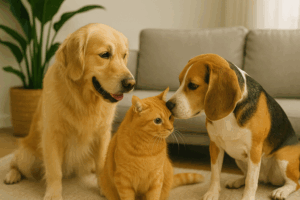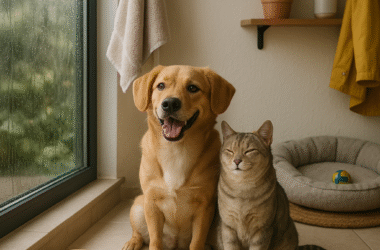Living with multiple pets is rewarding but demands effort, planning, and patience. Managing different species or breeds in one home requires structure. Every pet has individual needs that must be met simultaneously. Their food, medical attention, and emotional requirements differ significantly. Without proper care, tension among pets can develop easily. Owners must maintain routine and discipline in the house. Cleanliness is also a key concern in a multi-pet environment. Regular grooming and sanitation become even more important with several animals. Feeding schedules, playtime, and rest areas must be well-organized. Behavioral observation is necessary to ensure no pet feels neglected. Creating personal space for each pet is essential for harmony. Attention must be equally divided to avoid jealousy or aggression. Introducing pets gradually helps reduce stress in new environments. This guide explains how to handle multiple pets under one roof with ease, comfort, and minimal stress for both pets and owners.
Create Structured Zones for Each Pet
Each pet needs a separate zone within the house. Zones help manage individual habits and behaviors better. Assign personal feeding areas to avoid food aggression or stealing. Use labeled bowls for clarity and discipline. Cats prefer quiet spaces, while dogs enjoy social spots. Rabbits or birds need specific temperature control. Avoid mixing resting areas unless pets are bonded. Separate beds help avoid territorial fights. Maintain designated play zones indoors or outdoors. Don’t let toys become a reason for conflict.

Use gates or barriers to control access to rooms or stairs. Boundaries make pets feel secure.
Ensure litter boxes and potty areas are away from eating zones. Clean these areas multiple times a day.
Always have more litter boxes than the number of cats. This reduces the chances of accidents and fights.
Keep water stations in neutral areas. Hydration should be accessible to all without interference.
Having these zones brings peace and prevents behavioral issues in a house full of pets.
Feed and Train Pets Separately and Equally
Multiple pets mean multiple appetites and personalities. Feeding should be scheduled and supervised strictly. Avoid free-feeding methods unless all pets are equally calm and non-territorial. Feed pets in separate rooms or corners. This ensures no pet feels threatened or left out. Give equal attention while training each pet. Individual learning speed must be respected. Use separate commands if needed, especially when pets are of different species.

Never punish a pet for reacting to others during mealtime. Manage their distance better instead.
Reward-based training works best for multi-pet homes. Use treats wisely to avoid competition.
Train them to respond to names and hand signals. This minimizes confusion and cross-reactivity.
Always maintain consistency with rules. If one isn’t allowed on the sofa, none should be.
Don’t encourage rivalry through favoritism. Balanced love keeps the household stress-free and harmonious.
Observe Behavior and Offer Equal Emotional Support
Observe each pet’s body language daily. Pets show emotions through gestures, not words.
Look for signs of stress, fear, or aggression during group activities. If one pet hides or avoids interaction, address it immediately. Never let fear grows silently. Give individual cuddle time to each pet every day. Emotional attention cannot be generalized. Avoid forcing pets to play or sleep together. Let bonding happen naturally and gradually. Have regular health checkups and vet visits for all pets. Undiagnosed issues can lead to behavioral problems.

Use calming sprays or pheromone diffusers if tensions arise. Keep the environment peaceful at all times. Don’t ignore senior pets while caring for new ones. Age demands more emotional support.
Allow older pets more rest and fewer distractions. Give young pets extra playtime and training. Equal emotional support prevents jealousy, anxiety, and even illness among pets. Balance keeps everyone safe and happy.
Utpal Khot
Copyright © Utpal K
1. If you share this post, please give due credit to the author Utpal Khot
2. Please DO NOT PLAGIARIZE. Please DO NOT Cut/Copy/Paste this post.
© Utpal K., all rights reserved.
Copyright Notice: No part of this Blog may be reproduced or utilized in any form or by any means, electronic or mechanical including photocopying or by any information storage and retrieval system, without permission in writing from the Blog Author Utpal Khot who holds the copyright.





